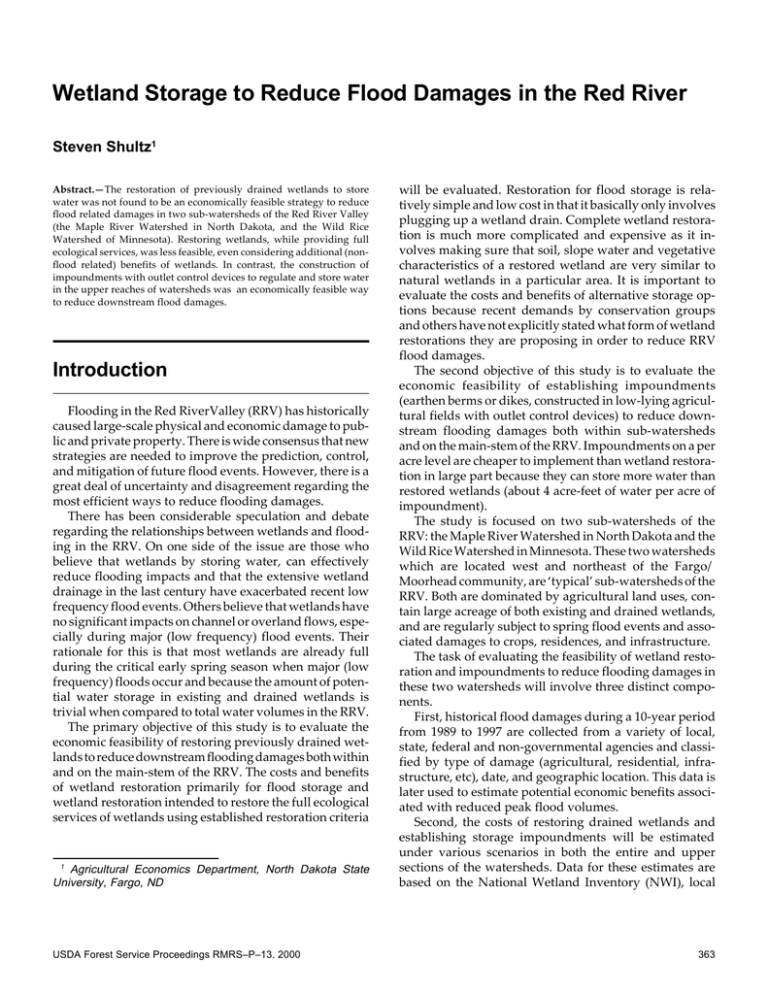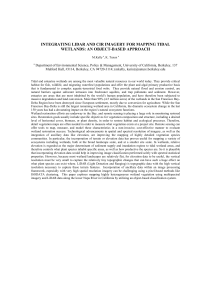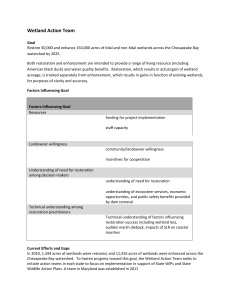will be evaluated. Restoration for flood storage is rela-
advertisement

Wetland Storage to Reduce Flood Damages in the Red River Steven Shultz1 Abstract.—The restoration of previously drained wetlands to store water was not found to be an economically feasible strategy to reduce flood related damages in two sub-watersheds of the Red River Valley (the Maple River Watershed in North Dakota, and the Wild Rice Watershed of Minnesota). Restoring wetlands, while providing full ecological services, was less feasible, even considering additional (nonflood related) benefits of wetlands. In contrast, the construction of impoundments with outlet control devices to regulate and store water in the upper reaches of watersheds was an economically feasible way to reduce downstream flood damages. Introduction Flooding in the Red RiverValley (RRV) has historically caused large-scale physical and economic damage to public and private property. There is wide consensus that new strategies are needed to improve the prediction, control, and mitigation of future flood events. However, there is a great deal of uncertainty and disagreement regarding the most efficient ways to reduce flooding damages. There has been considerable speculation and debate regarding the relationships between wetlands and flooding in the RRV. On one side of the issue are those who believe that wetlands by storing water, can effectively reduce flooding impacts and that the extensive wetland drainage in the last century have exacerbated recent low frequency flood events. Others believe that wetlands have no significant impacts on channel or overland flows, especially during major (low frequency) flood events. Their rationale for this is that most wetlands are already full during the critical early spring season when major (low frequency) floods occur and because the amount of potential water storage in existing and drained wetlands is trivial when compared to total water volumes in the RRV. The primary objective of this study is to evaluate the economic feasibility of restoring previously drained wetlands to reduce downstream flooding damages both within and on the main-stem of the RRV. The costs and benefits of wetland restoration primarily for flood storage and wetland restoration intended to restore the full ecological services of wetlands using established restoration criteria 1 Agricultural Economics Department, North Dakota State University, Fargo, ND USDA Forest Service Proceedings RMRS–P–13. 2000 will be evaluated. Restoration for flood storage is relatively simple and low cost in that it basically only involves plugging up a wetland drain. Complete wetland restoration is much more complicated and expensive as it involves making sure that soil, slope water and vegetative characteristics of a restored wetland are very similar to natural wetlands in a particular area. It is important to evaluate the costs and benefits of alternative storage options because recent demands by conservation groups and others have not explicitly stated what form of wetland restorations they are proposing in order to reduce RRV flood damages. The second objective of this study is to evaluate the economic feasibility of establishing impoundments (earthen berms or dikes, constructed in low-lying agricultural fields with outlet control devices) to reduce downstream flooding damages both within sub-watersheds and on the main-stem of the RRV. Impoundments on a per acre level are cheaper to implement than wetland restoration in large part because they can store more water than restored wetlands (about 4 acre-feet of water per acre of impoundment). The study is focused on two sub-watersheds of the RRV: the Maple River Watershed in North Dakota and the Wild Rice Watershed in Minnesota. These two watersheds which are located west and northeast of the Fargo/ Moorhead community, are ‘typical’ sub-watersheds of the RRV. Both are dominated by agricultural land uses, contain large acreage of both existing and drained wetlands, and are regularly subject to spring flood events and associated damages to crops, residences, and infrastructure. The task of evaluating the feasibility of wetland restoration and impoundments to reduce flooding damages in these two watersheds will involve three distinct components. First, historical flood damages during a 10-year period from 1989 to 1997 are collected from a variety of local, state, federal and non-governmental agencies and classified by type of damage (agricultural, residential, infrastructure, etc), date, and geographic location. This data is later used to estimate potential economic benefits associated with reduced peak flood volumes. Second, the costs of restoring drained wetlands and establishing storage impoundments will be estimated under various scenarios in both the entire and upper sections of the watersheds. Data for these estimates are based on the National Wetland Inventory (NWI), local 363 agricultural land prices, and previously conducted wetland restoration studies (Sip, 1998 and Eppich et al., 1998). The final component of the feasibility evaluation involves evaluating the costs of alternative storage options with potential benefits over a 10-year period. Potential benefits are based on the results of a hydrological modeling exercise conducted by Bengston and Padmanabhan (1999), and the assumption that wetland storage volumes are directly or linearly related to reduced peak flood volumes and reduce flood damages. Alternative Storage Programs The location and quantity of previously drained wetlands in the watersheds were identified though a GIS based search of the National Wetlands Inventory (NWI). However, it is likely additional drained wetlands, especially those drained many years ago, are not captured in this database. For this reason, the feasibility of using wetland restoration to reduce flooding damages are also evaluated under the assumption that there are 50% more drained wetlands than captured in the NWI. Wetland restoration options are considered for implementation in the entire and upper sections of the watersheds. Finally, an evaluation is made of wetland restoration only on relatively low cost lands in the upper parts of the watersheds. In the Maple, there are approximately 2,900 acres of drained wetlands in the entire watershed and 2,700 acres in the upper watershed. In the Wild Rice Watershed there are approximately 17,200 acres of drained wetlands in the entire watershed and 12,200 acres in the upper watershed. Because the estimation of specific areas and locations available for impoundments requires detailed topological (elevation) data, our feasibility analysis of impoundments in the Maple and Wild Rice watershed will focus on a somewhat arbitrary but likely quantity of impoundments (3% of the total croplands in the watersheds). This would mean that 24,000 acres of cropland could be impounded in the Maple River Watershed and 12,500 acres in the Wild Rice Watershed. Because impoundments have outlet control devices, they and can store more water than restored wetlands (about 4 acre-feet of water per acre of impoundment versus the 1 acre-foot assumed for restored wetlands). Costs of Storage Programs Based on two reviews of wetland restoration costs in Northwest Minnesota (Sip, 1998 and Eppich et al., 1998), 364 the initial construction costs required to restore wetlands for the purposes of water storage (without outlet flows) are estimated to be $300/acre. The cost of restoring wetlands with full ecological functions (i.e., following Minnesota wetland restoration standards) is estimated at $3,000/ acre while impoundments are estimated to cost $475/acre to construct. Payments to farmers for the storage of water on their lands ($/Acre) are considered to be the same regardless of the storage option being evaluated. Annual rental payments are used because they require less up-front costs, it is not known how long the storage programs will be required, and because reasonably accurate annual rental data exists for the study area. Land rental values in the Maple River Watershed were obtained from average county level cropland rental values from 1993-1997 as reported by the North Dakota Agricultural Statistics Service. In the Wild Rice Watershed annual land value rates were estimated by making adjustments to assessed land values reported by the Minnesota Department of Revenue. Total costs of wetland storage over 10 years are a summation of the present value of construction costs in year 1 and land rental payments in years 1 through 10. A discount rate of 5% was used to calculate present values. Five different wetland restoration options are evaluated for each watershed. The first two scenarios are focused on the entire watershed using NWI estimates of drained wetlands and then the assumption that there exists 50% more drained wetlands available for restoration. The remaining three wetland-storage scenarios are focused only in the upper sections of the watersheds. Again the first two are associated with drained wetlands using the NWI estimates of drained wetlands and then with an additional 50%. The last scenario involves restoring wetlands only in areas of the upper watersheds with the cheapest land rentals. This scenario requires the assumption that the total amount of drained wetlands exceed NWI estimates by 50% but because only the cheapest lands are utilized, total wetland acres restored are approximately equal to original NWI estimates. Wetland restoration costs over a ten-year period range from $1.4 million to $2.8 million in the Maple River Watershed and between $7.1 million and $14 million in the Wild Rice. Restoring wetlands with full ecological services costs between $8.4 million and $12.8 million in the Maple Watershed and between $53.5 million and $80.3 million in the Wild Rice Watershed. Wetland restoration costs are obviously dependent on the amount of wetland acres restored. Therefore, a useful indicator of the relative cost of alternative restoration scenarios is the annual cost per acre-foot of water stored (under the assumption that restored wetland store 1 acre- USDA Forest Service Proceedings RMRS–P–13. 2000 foot of water per surface acre of wetland). Wetland restoration in the Maple River Watershed costs between $54 and $64 per acre-foot of stored water and between $310 to $321 per acre foot of stored water when full ecological services of wetlands are provided. In the Wild Rice watershed restoration for storage purposes costs between $39 and $54 per acre foot of storage and between $305 and $311 per acre-foot of storage when all ecological services are restored. Approximately 24,000 acres of the upper Maple River watershed could potentially be impounded at a cost of about $18.2 Million over a 10-year period. The corresponding values for the upper Wild Rice watershed are 12,500 acres impounded at a cost of $ 8.7 Million over a 10year period using average cropland rental rates in the two watersheds. Assuming that such impoundments can store 4 acre-feet of water by draining water in the preceding fall and early in the spring before major flood events. Therefore, approximately 96,000 acre-feet of water would be stored in the Maple Watershed and 50,000 acre-feet would be stored in the Wild Rice Watershed . The annual cost of impounding an acre-foot of water is $19 in the Maple Watershed and $18 in the Wild Rice Watershed, which is considerably cheaper than any wetland restoration based storage options. Potential Benefits of Storage Alternatives Flood damages within the watersheds as estimated by Kjelland (1999), are $21.6 million for the Maple and $90.3 million for the Wild Rice, both over a 10-year period. Flood related damages outside the sub-watersheds are assumed to be directly related to flooding in the downstream city of Grand Forks for which 10-year damages (based on the 1997 flood event) are estimated to be $9.8 million. A hydrological modeling exercise of the Maple River watershed found that storage associated with restoring 2700 acres of wetlands reduced peak flows by 2.4% and flow volumes by 3.4% (Bengtson and Padmanahbahn, 1999). Therefore for all the storage scenarios evaluated, it will be assumed that stored water reduces peak flood volumes (averaged over time) and flood damages proportionately. Average peak flood flows in the Maple Watershed over the last 20 years are 108,000 acre-feet while the corresponding number for the Wild Rice Watershed is 198,000 acre-feet. USDA Forest Service Proceedings RMRS–P–13. 2000 Conclusions: Feasibility of Storage Options Four out of the five wetland restoration-storage options have a negative benefit-cost ratio of approximately 1:2 meaning that their costs are twice their expected benefits; therefore, they are not profitable or feasible. The only wetland restoration based storage option that is profitable is in the upper Wild Rice Watershed based on the assumption that there are 50% more drained wetland acres than appear in the NWI. It is also assumed that wetland restoration would occur on only low cost lands (with rental values below the median level of the entire watershed). Even with these optimistic assumptions this option is just barely feasible with benefits exceeding costs by only $300,000 (5% of the total costs). Other assumptions in this evaluation were that wetlands can store an acrefoot of water per surface acre, that such storage directly reduces flood peak volumes and flood damages proportionately, and that the 10-year ‘wet cycle’ for which flood damages were collected is expected to continue. Wetland restoration that provides full ecological services is even more expensive and is not considered feasible under any scenarios evaluated. It was also estimated that in order for this type of restoration to be feasible that non-flood related benefits of restored wetlands wound need to be between $2500 and $3000 per acre over 10years, which greatly exceeds previous wetland benefit estimates in the region (Leitch and Hovde, 1996) In contrast, the benefit-cost ratios of using impoundments to store water in the upper reaches of the watersheds and prevent downstream flooding were estimated to be 1.5 to 1 in the Maple and 2.8 to 1 in the Wild Rice. Therefore, the use of impoundment based storage in each of the watersheds appears to be an economically feasible way to reduce downstream flooding damages both within the watersheds and in a downstream (main-stem) community. Further research is warranted on the site-specific hydrological implications of alternative impoundment strategies and the short and long-term effects of impoundments on the ecological systems within sub-watersheds. Acknowledgments The author would like to thank Jay Leitch and David Lambert, Full Professor and Department Chair, respectively in the Agricultural Economics Department at North Dakota State University for providing technical reviews 365 of this manuscript. The International Joint Commission Red River Basin Taskforce provided funding for this research. All potential errors contained in the manuscript are the full responsibility of the author. Literature Cited Bengston, M. and G. Padmanabahn. 1999. A Hydrological Model for Assessing the Influence of Wetlands on Flood Hydrographs in the Red River Basin. Report Submitted to the International Joint Commission Red River Task Force, July 1999. 366 Eppich, D., Apfelbaum, S., Lewis, L. 1999. Small Wetlands Use for Stormwater Runoff Management in the Red River of the North Basin. Applied Ecological Services, Inc.Kjelland, M. 1999. Unpublished Masters Thesis. Department of Agriculture Economics. North Dakota State University, Fargo. Leitch, J.A. and B. Hovde, 1996. Empirical valuation of prairie potholes: Five case studies. Great Plains Research, 6:25-39. Sip, R. L. 1998. An Economic Assessment of Wetland Mitigation in Northwest Minnesota. Masters Thesis, Department of Agricultural Economics. North Dakota State University, Fargo. USDA Forest Service Proceedings RMRS–P–13. 2000




